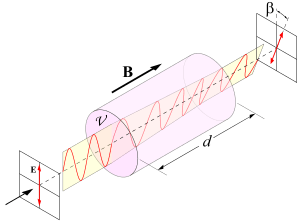Faraday rotator
A Faraday rotator is a polarization rotator based on the Faraday effect, which in turn is based on a magneto-optic effect. It works because one polarization of the input light is in ferromagnetic resonance with the material which causes its phase velocity to be higher than the other.

The plane of linearly polarized light is rotated when a magnetic field is applied parallel to the propagation direction. The empirical angle of rotation is given by:
where is the angle of rotation (in radians), is the magnetic flux density in the direction of propagation (in teslas), is the length of the path (in metres) where the light and magnetic field interact, and is the Verdet constant for the material. This empirical proportionality constant (in units of radians per tesla per metre, rad/(T·m)) varies with wavelength and temperature[1] and is tabulated for various materials.
Faraday rotation is an example of non-reciprocal optical propagation. Unlike what happens in an optically active medium such as a sugar solution, reflecting a polarized beam back through the same Faraday medium does not undo the polarization change the beam underwent in its forward pass through the medium. This allows Faraday rotators to be used to construct devices such as optical isolators to prevent undesired back propagation of light from disrupting or damaging an optical system.
The geometry of non-reciprocal propagation may at first appear paradoxical. In an optically active medium, the polarization direction twists or rotates in the same sense (e.g. like a right-handed screw) during both the forward and backward passes, reversing the original rotation and returning the incident beam to its original polarization. Conversely, in a Faraday medium, because the light reverses its propagation direction with respect to the magnetic field, the helicity of the propagation also reverses. But because the propagation axis has also reversed, this reversal of helicity is just what is needed to cause the back-reflected light to have polarization different from that of the incident light. One application of non-reciprocal propagation is to completely block any back-reflection; if the Faraday medium is of such thickness as to cause a 45 degree rotation on the way in, the back-reflected beam will undergo an additional 45 degree rotation in the same sense, resulting in the beam being polarized at 90 degrees, i.e., perpendicular to that of the incident beam, and allowing it to be cleanly blocked by the light source's polarizer.
Faraday rotators may be enhanced by the Zeeman effect.[2]
See also
References
- Vojna, David; Slezák, Ondřej; Lucianetti, Antonio; Mocek, Tomáš (2019). "Verdet Constant of Magneto-Active Materials Developed for High-Power Faraday Devices". Applied Sciences. 9 (15): 3160. doi:10.3390/app9153160.
- Popescu, Alexandru; Walther, Thomas (2005). "On the potential of Faraday anomalous dispersion optical filter as high-resolution edge filters". Laser Physics. 15 (1): 55–60. Archived from the original on 2012-12-18. Retrieved 2007-03-13.